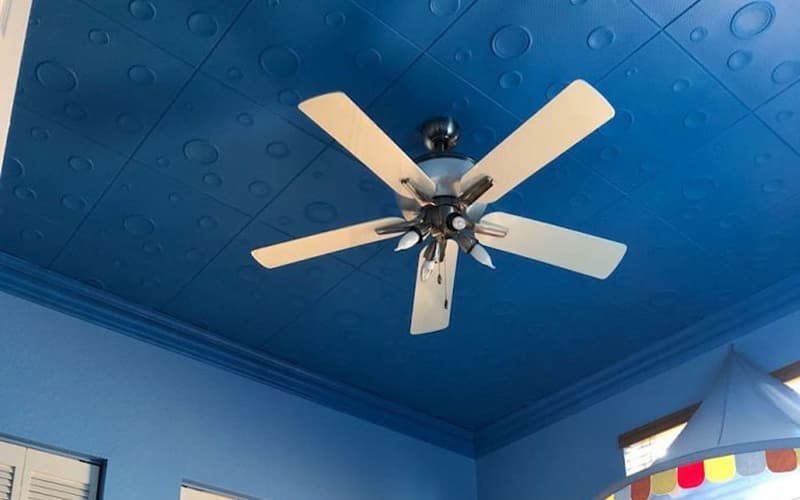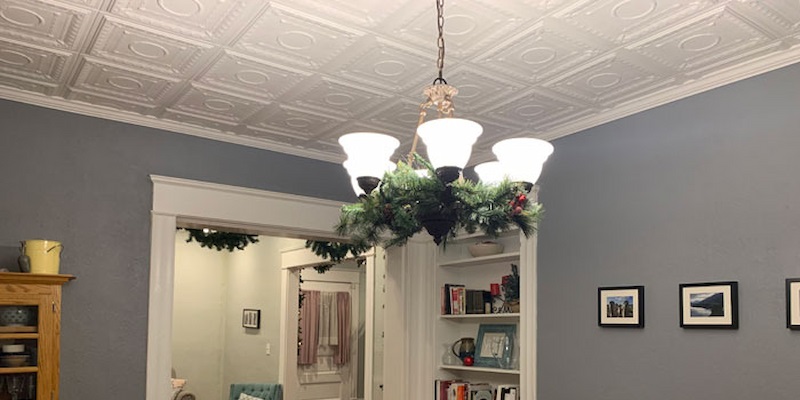People are now using suspended ceiling tiles because it allows easy plumbing and electrical maintenance. However, the color of the tiles may not match the room’s colors. Can you paint ceiling tiles if the original color does not complement the room’s overall aesthetics?
You can paint your ceiling tiles if you follow the proper painting procedure and pick the correct paint that matches the ceiling panel material. You may need proper preparation and priming to obtain a quality result. It would be best if you also thought about how the painting project affects the tile’s fire resistance and acoustic abilities.
Stick around to learn important things on how to proceed in painting your suspended ceiling panels. You will also get ideas on what paint to use for your painting project. Finally, I will provide the general step-by-step process as your guide.

Is it Possible to Paint Ceiling Tiles?
Painting your ceiling tiles because they look old and worn out or the color does not complement the room colors is a plausible idea. There is no reason why you won’t improve the tile’s color if necessary.
However, there are many things to consider before starting your project. First off, you must know what the tiles are made of so that you can match the type of paint to use. Ceiling tiles are generally made of foam, gypsum, plastic, fiberglass, starch, mineral wool, metal, wood, and others.
These different materials may require a specific type of paint and a unique paint application procedure. These materials may also have different preparation methods to ensure paint adhesion.

Ceiling tiles are also sometimes used to obtain a certain acoustic quality in the room. You would need to research or ask experts whether painting the tiles will compromise this function.
Deciding on the best application method is also important. You may spray paint if possible, as it is faster. But that method is not ideal if the area you are painting is not properly ventilated.
Suppose the risk of unnecessarily spreading paint particles to other surfaces is high, don’t spray the paint. In that case, you can use a paintbrush or roller.
Do I Need to Prep Ceiling Tiles Before Painting?

Like any surface, ceiling tiles also need pre-painting preparation. Many things can go wrong if you do not prep the surface when painting. However, you will always get a high-quality finish if you prepare the surface.
You might hear some people say that surface preparation is not always needed. But I insist that you should not skip it because it ensures result quality. Painting over dirt or dust can easily end up in a painting disaster.
Things You Need to Prepare Ceiling Tiles
- Drop cloth or plastic sheeting
- Broom or duster
- Dishwashing soap or any cleaning solution
- Water
- Tack cloth
- Absorbent cloth
- Painter’s or masking tape
- Sandpaper
- Caulk or spackling compound (in case repairs are necessary)
- Putty knife
- Primer
- Protective gears
Steps to Prepare Ceiling Tiles
Ceiling tiles preparation can be easier if you do it before the installation. However, if the tiles are already mounted, you can use the steps below as a guide.
Step 1: Wear your protective gear before you start your surface preparation.
Step 2: Secure the floor and furniture with drop cloth or plastic sheeting. You also need to cover all furniture and other things in the room.
Step 3: Uninstall the tiles when possible. Otherwise, keep them on the frame and proceed to the next step.
Step 4: Clean the tiles from dirt and dust using your broom or duster.
Step 5: Repair apparent damages.
Step 6: Wash the tiles with your cloth and cleaning solution.
Step 7: Let the tiles dry for a couple of hours. You can use your absorbent cloth to speed up the drying.
Step 8: Lightly sand the tiles using find-grit sandpaper.
Step 9: Clean the tiles from the sanding dust using your tack cloth. Do not use compressed air or a blower if you do not want the dust flying around the room.
Step 10: Prime the tiles to ensure paint adhesion.
Painting Ceiling Tiles: Step-by-Step Process
Painting your ceiling tiles is not as simple as brushing or spraying the paint directly on the surface. You need to follow certain steps to achieve your desired result.
Things You Need to Paint Ceiling Tiles
- Plastic sheeting or drop cloth (you can also use old newspapers)
- Masking or painter’s tape
- Protective gear (mask, goggles, hand gloves)
- Tack cloth
- Ladder
- Ceiling paint
- Paintbrush/paint roller/sprayer
Steps to Paint Ceiling Tiles
Step 1: Ensure the tiles are properly prepped before administering the paint.
Step 2: Lay down your drop cloth or plastic sheeting and cover the entire floor to secure it from dust and paint droplets. Also, cover all furniture. Use your painter’s or masking tape to avoid messing up the already-painted walls.
Step 3: Wear your mask, gloves, and goggles to protect yourself from dust and paint fumes.
Step 4: Prepare or mix the paint of your choice well by thoroughly stirring the solution.
Step 5: Apply a thin initial coating to the tiles and let them dry. The drying time varies depending on the type of paint you use. You will usually find the dry time of the paint on its container.
Step 6: Apply the second and final coating and let the paint dry. You may choose to do three coatings if you like.
Step 7: Allow the paint to dry for 24 hours.
Step 8: Clean the room. Remove all the plastic sheeting or old newspapers and the painter’s tape on your walls. You can wipe your walls with a tack cloth to remove the dust.
What Kind of Paint Do You Use on Ceiling Tiles?
There are different materials used for making ceiling tiles—the ceiling tile’s material matters in choosing which paint to use.
For plastic and wood-made ceiling tiles, it is best to use an oil-based primer and pair it with oil-based paint. However, there is an alternative if you want to speed up your painting job or minimize exposure to hazardous toxins.
You can also consider using water-based ceiling paints over oil-based primers. Water-based paints also stick very well to oil-primed surfaces.
If you have acoustic ceiling tiles, you need to be extra cautious in choosing the right paint. You must ensure that you choose the paint that does not impact the tile’s sound absorption capability.
You can purchase latex paint in the market dedicated to painting acoustic components, such as the Acousti-Coat.
Ceiling tiles made of metal are best painted with enamel ceiling paints. You can also use enamel car paints because they give an excellent finish.
What is the Difference Between Ceiling Paint and Regular Paint?
Many people wonder if they can use any paint to paint ceilings. Technically, you can use whatever paint you wish, but the result may not be the same.
Ceiling paints are more viscous than regular paints. This characteristic of the ceiling paint ensures that it does not drip during application. It also increases its ability to hide stains and other imperfections.
Ceiling paints are usually flat sheen or less shiny compared to regular paints. The flatness of ceiling paints allows them to effectively hide scratches, damages, and imperfections.
Also, using flat ceiling paints minimizes reflections, which may affect the overall ambiance. You can check the other benefits of using flat paint here.
Paint experts also agree that ceiling paints naturally adhere better than other paints.
Is it Better to Paint Ceiling Tiles With a Brush or Roller?
The ceiling is probably one of the most difficult surfaces to paint. Painting installed ceiling tiles can be challenging. You are prone to getting paint splatter all over yourself.
Ceiling tiles painting is a lot easier using a roller. A paint roller allows you to achieve thin and even coats. Compared to the paintbrush, rollers are also generally more economical.
Nap rollers are preferred for ceiling painting because they evenly spread paint with less splatter. Foam rollers also tend to leave ugly lines on the surface.
Although you mainly use a nap roller to paint your ceiling tiles, a paintbrush is still necessary. You will use the paintbrush to paint the edges between the ceiling and the walls.
Some people use a ladder when painting ceiling tiles. However, connecting a stick to your nap roller may minimize getting the splatter over your body.
Does Painting Ceiling Tiles Affect Fire Rating?
Fire prevention is a big deal because of the obvious harmful effects. The ceiling is one of the areas in the house where fire can easily spread. Because of this, people are switching to ceiling tiles that do not easily attract fire.
When we talk about fire ratings, we refer to the Surface Burning Characteristics Rating and the Fire Barrier Rating.
The former pertains to how the tile reacts to fire or how fast it spreads the fire. On the other hand, the latter refers to how well the ceiling panel resists or prevents the spread of fire.
The question of most people who plans to paint their ceiling tiles is, will it affect the tile’s fire ratings? The fact that paints are highly associated with fire may have triggered the question.
Painting the ceiling tiles can affect their fire rating. However, if you want to paint them because it is necessary, avoid using oil-based paints when possible. Oil paints contain highly flammable chemicals.
Instead, people often use water-based paints such as acrylic or latex. Water-based paints require a great amount of temperature before they burn. They still affect ceiling tiles’ fire rating but do not compromise it completely.
More Tips to Know when Painting Ceiling Tiles
- Ventilate the area properly before you start painting by opening the windows.
- Properly prep the ceiling tiles before painting to avoid regrets.
- Use water-based paints if possible. Water-based paints work best on wood or plastic ceiling tiles.
- Don’t skip the primer to ensure a high-quality result.
- Dark colors on the ceiling can make the room feel cozier.
Conclusion
You can paint ceiling tiles, but you must consider how it affects the fire rating. Water-based paint is ideal because it does not affect the tile’s fire rating much.
Ceiling tiles preparation and priming are advisable to ensure that you will get a quality result. It is best to use a nap paint roller when painting your ceiling as it allows you to evenly spread a thin layer of paint all over the surface.
